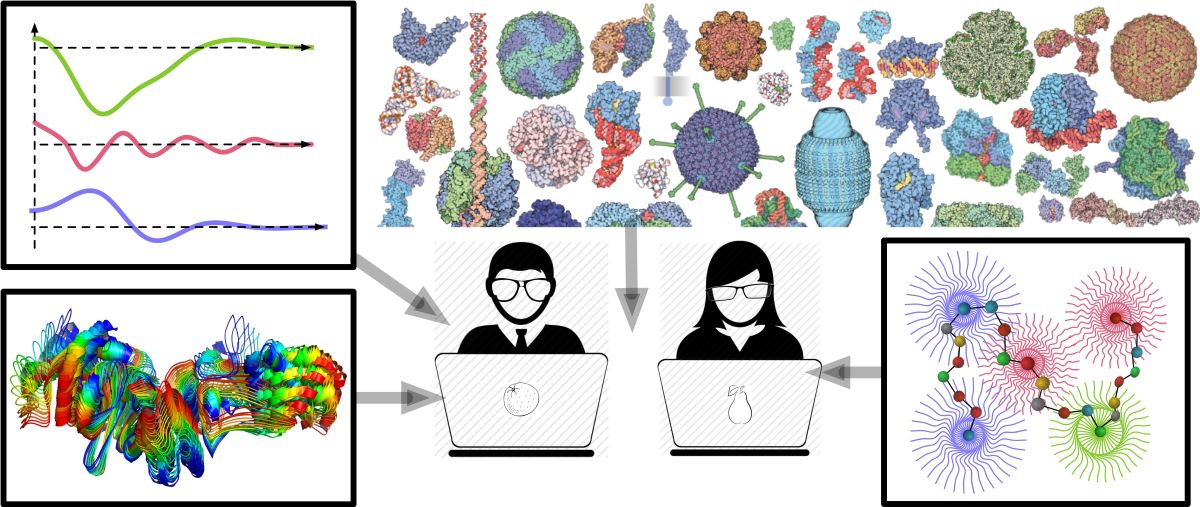Recent progress in protein structure prediction significantly enhanced integrative structure modeling of large macromolecular assemblies by providing improved structural coverage for individual proteins and protein-protein interactions. However, direct prediction of large protein assemblies remains a challenge. I will introduce CombFold, a hierarchical and combinatorial assembly algorithm...
To perform their functions, proteins frequently interact with other proteins and nucleic acids. Detailed information on these interactions can be obtained from the three-dimensional structures of the corresponding protein-protein or protein-nucleic acid complexes. Since the experimental structure determination is often tedious and expensive, computational structure prediction methods are...
Studying specificity in protein–glycosaminoglycan recognition with umbrella sampling
Abstract
Glycosaminoglycans (GAGs) with repeating disaccharide units intricately engage with proteins, playing a crucial role in the spatial organization of the extracellular matrix and the transduction of biological signals in...
Molecular visualization is a critical task usually performed by structural biologists and bioinformaticians to aid three processes that are essential in science and fundamental to understand structural molecular biology: synthesis, analysis and communication [1].
Here we present VTX, a molecular visualization software that includes a real-time high-performance molecular graphics engine...
Generating large amplitude conformational changes of complex biomolecules remains a challenge. This talk will review recent work on this problem, based on novel insights on loop closure techniques coupling kinematic models in dihedral angle spaces and MCMC sampling techniques of the Hit-and-Run type. Along the way, I will discuss connections with density of states calculations and...
Given a molecular structure, it can be represented as a set of atomic balls, each ball having a van der Waals radius corresponding to the atom type. A ball can be assigned a region of space that contains all the points that are closer (or equally close) to that ball than to any other. Such a region is called a Voronoi cell and the partitioning of space into Voronoi cells is called Voronoi...
In recent years, computational protein engineering has become instrumental in developing drugs and therapies, especially with the rise of machine learning-based methods, that pushed the performance of such tools to a new level of accuracy. Despite the progress, such approaches still present limitations in terms of robustness and complexity of the design objectives they can accomplish. Two of...
The number of known folds is limited to a few thousand and this number is surprisingly low, several orders of magnitude lower than the number of sequences in the biosphere. Biological or physical constraints may considerably limit the repertoire of folds. In this case, structural convergence should be frequent. However, several studies showed that distribution in proteomes may be a global...
The elucidation of different conformations of biomolecular complexes is the key to understand the molecular mechanisms behind the biological functions of the complexes and the key to novel drug discovery. Single-particle cryo electron microscopy (cryo-EM) allows 3D reconstruction of multiple conformations of purified biomolecular complexes from their 2D images. Cryo electron tomography...
Proteins can have very different architectures, generally involving a concatenation of relatively rigid domains and flexible regions. Indeed, many proteins in eukaryotes, prokaryotes and viruses are composed of several domains connected by linkers, and flexible tails are also frequently found at the termini of rigid domains. Besides, flexible loops connecting secondary structure elements...
Peripheral membrane proteins (PMPs) are soluble proteins that bind transiently to the surface of cell membranes. Having the ability to exist in both a soluble and a membrane-bound form their membrane-binding region is constrained to retain a fine balance of polar and hydrophobic character, which makes it difficult to distinguish it from the rest of their surface. As a result peripheral...
The decomposition of a biomolecular complex into domains is an important step to investigate biological functions, and is also relevant to ease structure determination. A successful approach to do so is the SPECTRUS algorithm, which provides a segmentation based on spectral clustering applied to a graph coding inter-atomic fluctuations derived from an elastic network model. We present a...
Histone chaperones play a crucial role in regulating the assembly and disassembly of chromatin. Our lab recently reported a novel chaperone binding mode in which histone chaperone APLF single-handedly assembled the histone complexes H2A-H2B and H3-H4 into the histone octamer. The chaperone domain of APLF consists of a short (~60 aa) intrinsically disordered, highly acidic domain (AD). As we...
The continuous development of the methods for the protein structure prediction was taking advantage from the precious experimental information obtained by structural biology as well as by sequencing of multiple organisms. Indeed, the general developed pipeline is based on determining conformations of protein fragments, and then using multiple sequence alignments to obtain long-range distances...
The Nuclear Pore Complex (NPC) is one of the larger macromolecular complexes in eukaryotic cells. The NPC facilitates rapid and selective transport between the cytoplasm and the nucleus. Existing models of transport do not provide quantitative mechanistic explanations of how some key emergent properties such as the rapid transport rates of molecules as large as ribosomal units and viral...
Protein oligomers can modify their overall architecture in response to changes in the environment, such as ion concentration and composition, the presence of small ligands or mechanic stress. These changes may involve small variations in the subunit-subunit interface which can lead to important changes in the overall shape due to multiplication effect. They may also involve large interface...
Rotary ATPases are multisubunit enzyme complexes that couple synthesis or hydrolysis of ATP molecules with transport of ions across a membrane. Their transmembrane part includes a homo- or a heterooligomer of c subunits called a c-ring, with a patch of several lipids confined inside it. Little is known about this patch; it is usually not well resolved in experimental structures, but it is...

